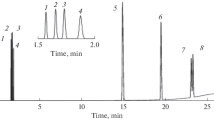Summary
High resolution glass-capillary gas chromatography can be used as a powerful identification tool for single components in complex mixtures, when the matching of retention indices of reference compounds with those found in the sample is based on precise measurements. Besides the constancy of the GC-parameters high precision measurements of retention indices require an accurate determination of net retention times. Special care has to be taken for an accurate measurement of retention times when using a dead-time calculation on the basis of an enforced linearisation of the log t s/homologues-number relationship. The reproducibility of precise retention-index determinations strongly depends on the constancy of the polarity and on the adsorptivity of the capillary column. Provided a sufficiently deactivated and conditioned high performance capillary column (separation number ≥40) and an accuracy of retention-time measurement of better than 0,05 % retention indices can be reproduced within ±0.15 i.u. over a period of several weeks. A conversion of the n-alkane based retention-index concept to the use of the homologous series of n-alkyl-trichloro-acetates (ATA) allows the use of the electron-capture detector (ECD) for precise retention-index determinations for a reliable identification of compounds in the picogram range.
Zusammenfassung
Der Vergleich von präzise bestimmten Retentionsindices von Probe- und Referenzsubstanzen in der hochauflösenden Capillar-Gas-Chromatographie stellt eine aussagekräftige Methode der Identifizierung von Einzelkomponenten in komplexen Gemischen dar. Neben der Konstanz der GC-Parameter erfordert die präzise Bestimmung von Retentionsindices eine sehr genaue Bestimmung der Netto-Retentionszeiten. Insbesondere ist bei Anwendung einer Totzeitberechnung auf der Basis einer erzwungenen Linearisierung der log t s/Homologenzahl-Beziehung auf eine sehr genaue Retentionszeitmessung zu achten. Die Reproduzierbarkeit von präzise bestimmten Retentionsindices hängt von der Konstanz der Polarität und von der Adsorptivität der Capillarsäule ab. An ausreichend desaktivierten und konditionierten Hochleistungs-Capillarsäulen (TZ≥40) können unter der Voraussetzung einer Retentionszeit-Meßgenauigkeit von besser als 0,05% Retentionsindices über einen Zeitraum von mehreren Wochen innerhalb ±0,15 Indexeinheiten reproduziert werden. Eine Übertragung des n-Alkan bezogenen Retentionsindex-Konzeptes auf die homologe Reihe der n-Allkyl-trichloracetate (ATA) ermöglicht die Verwendung des Elektroneneinfang-Detektors (ECD) zur präzisen RetentionsindexBestimmung als Methode einer zuverlässigen Identifizierung von Substanzen im Picogrammbereich.
Similar content being viewed by others
Literatur
Ballschmiter, K., Unglert, Ch., Neu, H. J.: Chemosphere 6, 51 (1977)
Ettre, L. S.: Chromatographia 6, 525 (1973)
Grob, K., Grob, G.: J. Chromat. Sci. 7, 584 (1969)
Grob, K., Grob, G.: Chromatographia 10, 250 (1977)
Groenendijk, H., von Kemenade, A. W. C.: Chromatographia 1, 442 (1968)
Haken, J. K.: Advances Chromatogr. 14, 367 (1975)
Kaiser, R. E.: Chromatographia 7, 251 (1974)
Kovats, E.: Helv. Chim. Acta 41, 1915 (1958)
Kovats, E.: Advances Chromatogr. 1, 229 (1965)
Neu, H. J., Buchert, H., Zinburg, R.: in Vorbereitung
Peterson, M. L., Hirsch, J.: J. Lipid Res. 1, 132 (1959)
Rohrschneider, L.: J. Chromatogr. 22, 6 (1966)
Schomburg, G.: Mitt. GdCH-Kurs 38/77 Mülheim (1977)
Schomburg, G., Dielmann, G.: J. Chromat. Sci. 11, 151 (1973)
West, S. D., Hall, R. C.: J. Chromat. Sci. 13, 5 (1975)
Zell, M., Neu, H. J., Ballschmiter, K.: Fresenius Z. Anal. Chem. 292, 97 (1978)
Zell, M., Neu, H. J., Ballschmiter, K.: Chemosphere 6, 69 (1977)
Author information
Authors and Affiliations
Rights and permissions
About this article
Cite this article
Neu, H.J., Zell, M. & Ballschmiter, K. Identifizierung von Einzelkomponenten in komplexen Gemischen durch Retentions-Index-Vergleich nach Capillar-Gas-Chromatographie mit Elektroneneinfangdetektor (ECD). Z. Anal. Chem. 293, 193–200 (1978). https://doi.org/10.1007/BF00491046
Received:
Issue Date:
DOI: https://doi.org/10.1007/BF00491046




